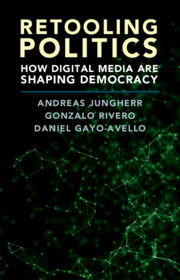Book contents
- Retooling Politics
- Retooling Politics
- Copyright page
- Contents
- Acknowledgments
- 1 The Rise of Digital Media and the Retooling of Politics
- 2 The Flow of Political Information
- 3 Reaching People
- 4 The Effects of Political Information
- 5 Digital Media and Collective Action
- 6 Changing Organizations
- 7 Data in Politics
- 8 Digital Media and Democracy
- 9 Digital Media in Politics
- References
- Index
6 - Changing Organizations
Published online by Cambridge University Press: 17 June 2020
- Retooling Politics
- Retooling Politics
- Copyright page
- Contents
- Acknowledgments
- 1 The Rise of Digital Media and the Retooling of Politics
- 2 The Flow of Political Information
- 3 Reaching People
- 4 The Effects of Political Information
- 5 Digital Media and Collective Action
- 6 Changing Organizations
- 7 Data in Politics
- 8 Digital Media and Democracy
- 9 Digital Media in Politics
- References
- Index
Summary
Organizations are a fixture in democratic politics. Parties, business groups, advocacy groups, unions, and lobbies represent groups of people who share a common interest and who join forces to exert influence in the political process (Abrahamsson 1993). Pluralists see organizations as a natural component of liberal politics and they welcome them in a political arena that they perceive should provide opportunities for decentralized and balanced competition among organized interests (Dahl 1956). Others are less positive in their assessment and are concerned with the fact that inequality lies at the very heart of organizations. First of all, they tend to represent those who already have a disproportionate presence in politics to begin with. Second, organizations, more often than not, engender internal differentials of power between the leaders and the rank-and-file members (Michels 1915). These two layers of external and internal inequality thus shift representation from ordinary citizens to political elites, thus inspiring distrust in organizations as vehicles for political participation on both the political left and right (Abrahamsson 1993).
- Type
- Chapter
- Information
- Retooling PoliticsHow Digital Media Are Shaping Democracy, pp. 158 - 178Publisher: Cambridge University PressPrint publication year: 2020



